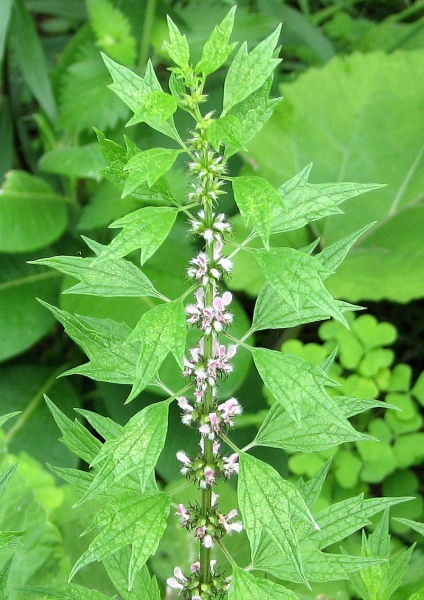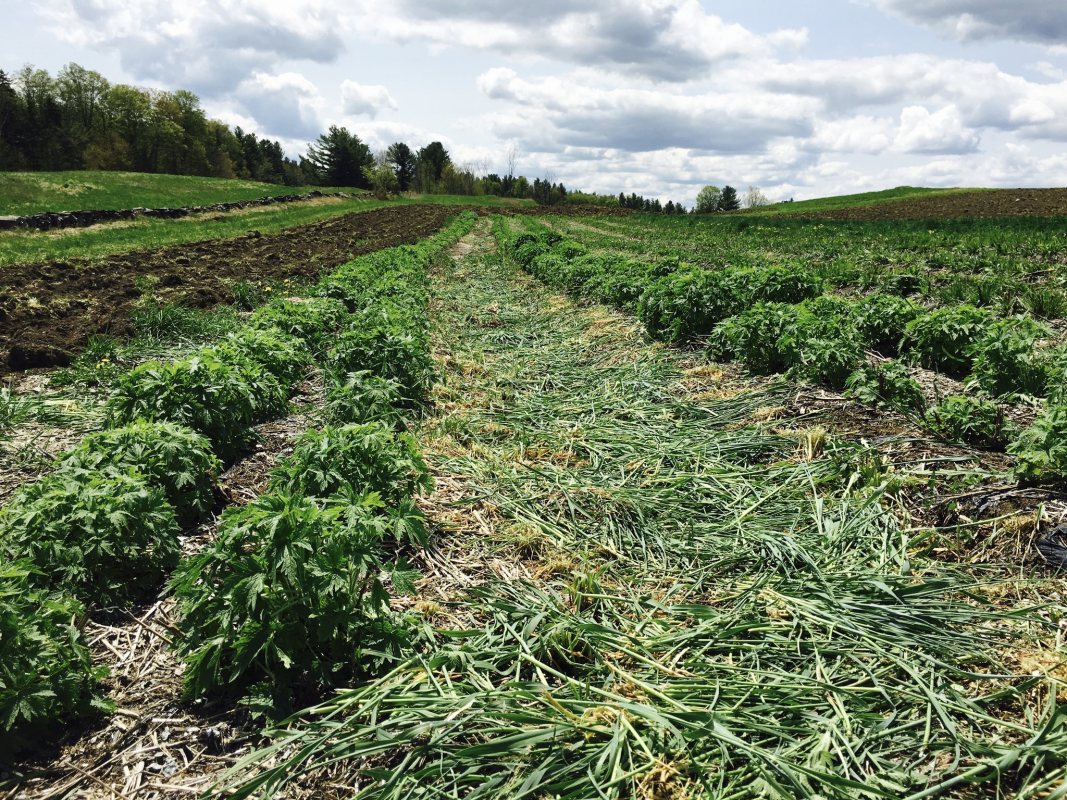 Leonurus
cardiaca. Motherwort,
Lion's Tail
Family: Lamiaceae (Mint family)
Leonurus
cardiaca. Motherwort,
Lion's Tail
Family: Lamiaceae (Mint family)
PART USED: Whole herb
TASTE: Very bitter ODOR: Slight
ACTIONS
GROUP: Sedative nervines
1. Sedative nervine.[1,2,3]
2. Antispasmodic.[1,2,3]
3. Astringent
4. Bitter tonic
5. Cardiac tonic.
6. Reproductive tonic.
7. Emmenagogue
INDICATIONS
1. Cardiac symptoms with mental/emotional factors. Palpitations. Simple tachycardia.[1] Heart weakness. Angina pectoris- especially after childbirth. Cardiac debility.[1] Effort syndrome.[1]
2. Neuritis. Neuralgias including sciatica. Cramps. Convulsions. Delirium, including delirium tremens.
3. Insomnia and nervousness.
4. Amenorrhea.[1] Dysmenorrhea. Uterine irritation or inflammation. Leukorrhea.
5. Stomach disorders. Diarrhea.
6. Nephritis. Suppression of urine. Albuminuria.
7. Rheumatic conditions
8. Colds and bronchial conditions
9. Convalescence from fevers.
SPECIFIC INDICATIONS: Cardiac symptoms associated with neurosis.[1]
COMBINATIONS
-False labour pains, with Black Horehound.
PREPARATIONS 3X/day
Dried herb, powder 2-4 g,[3] or by infusion[1] 1:20.
Fluid extract 1:1 in 25% alcohol 2-4 ml.[1,3]
Fluid extract 1:2 in 25% alcohol.[4]
Tincture 1:5 in 45% alcohol 2-6 ml.[1]


HABITAT: Grows in waste places in Europe and occasionally in Britain.
DESCRIPTION: Leaves stalked, palmately 5-7 lobed, serrate, downy on the undersurface with prominent, reticulate veins. Stems unbranched, quadrangular. Flowers downy, pinkish-purple or white, the lower lip spotted purple, about 12 mm long, in axillary whorls.
References
Inner Path can not take any responsibility for any adverse effects from the use of plants. Always seek advice from a professional before using a plant medicinally.

Constituents
Research
Studies in China have shown that extracts have antiplatelet aggregation actions and decrease the levels of blood lipids,[2,3] they also have an inhibitory effect on pulsating myocardial cells in vitro.[4] Therefore valuable for heart conditions.[5]
References
[1] British Herbal Pharmacopoeia 1983 Published by the British Herbal Medicine Association ISBN 0 903032 07 4.
[2] Chang, C. F. and Li, C. Z. (1986) Chung, I. Chieh Ho Tsa Chih 6 (1), 39
[3] Peng, Y. (1983) Bull. Chin. Mat. Med. 8, 41 966
[4] Xia, X. X. (1983) J. Trad. Chin. Med. 3, 185
[5] Potter's New Cyclopaedia of Botanical Drugs and Preparations R.C. Wren Revised by Elizabeth M. Williamson and Fred J Evans. First published in Great Britain in 1988 and reprinted in 1989 and 1994 by the C. W. Daniel Company Limited. 1 Church Path, Saffron Walden Essex. Published 1988 Printed and bound by Biddles, Guildford ISBN 085207 1973.
The effect of Leonurus cardiaca herb extract and some of its flavonoids on mitochondrial oxidative phosphorylation in the heart.
Bernatoniene J, Kopustinskiene DM, Jakstas V, Majiene D, Baniene R, Kuršvietiene L, Masteikova R, Savickas A, Toleikis A, Trumbeckaite S.
Abstract
Motherwort (Leonurus cardiaca) possesses antibacterial, antioxidant, anti-inflammatory, and analgesic activities, and is used as a complementary remedy to improve heart function and blood circulation. Since cardiovascular diseases are often associated with an alteration of mitochondria, the main producers of ATP in cardiac muscle cells, the aim of our work was to determine bioactive constituents present in motherwort aerial parts extract in ethanol and investigate their effects on the functions of cardiac mitochondria. Quantitative determination of polyphenols in L. cardiaca herb extract was performed by HPLC. Mitochondrial respiration rates were evaluated using a Clark-type oxygen electrode. Mitochondrial ROS generation was determined fluorimetrically with Amplex Red and horseradish peroxidase. The results showed that constituents (chlorogenic acid, orientin, quercetin, hyperoside, and rutin) of L. cardiaca herb extract uncouple (by 20-90?%) mitochondrial oxidation from phosphorylation, partially inhibit (by ~?40?%) the mitochondrial respiratory chain in cases of pyruvate and malate as well as succinate oxidation, and effectively attenuate the generation of free radicals in mitochondria. Since partial uncoupling of mitochondria, respiratory inhibition, and decreased ROS production are proposed as possible mechanisms of cardioprotection, our results imply that L. cardiaca herb extract could be a useful remedy to protect cardiac muscles from the effects of pathogenic processes.
Planta Med. 2014 May;80(7):525-32. doi: 10.1055/s-0034-1368426. Epub 2014 May 19. ncbi.nlm.nih.gov
Leonurus cardiaca L. (motherwort): a review of its phytochemistry and pharmacology.
Wojtyniak K, Szymanski M, Matlawska I.
Abstract
Leonurus cardiaca is a perennial plant indigenous to central Europe and Scandinavia, but it is also found in the area spanning temperate Russia to central Asia. It has been introduced to North America and has become established locally in the wild. Motherwort (Leonuri cardiacae herba) consists of aerial parts of Leonurus cardiaca gathered during the flowering period, dried at 35 °C and, according to European Pharmacopoeia 7th edition, should contain a minimum of 0.2% flavonoids, expressed as hyperoside. Compounds belonging to the group of monoterpenes, diterpenes, triterpenes, nitrogen- containing compounds, phenylpropanoids, flavonoids and phenolic acids, as well as volatile oils, sterols and tannins, have been identified in motherwort. Traditionally, extracts of the herb have been used internally, mainly for nervous heart conditions and digestive disorders. However, they have also been used for bronchial asthma, climacteric symptoms and amenorrhoea, as well as externally in wounds and skin inflammations. Mild negative chronotropic, hypotonic and sedative effects can be attributed to the herb and preparations thereof. Pharmacological studies have confirmed its antibacterial, antioxidant, anti-inflammatory and analgesic activity, as well as its effects on the heart and the circulatory system. Sedative and hypotensive activity has been demonstrated in clinical trials.
Phytother Res. 2013 Aug;27(8):1115-20. doi: 10.1002/ptr.4850. Epub 2012 Oct 8. ncbi.nlm.nih.gov
Leonurus cardiaca L. as a Source of Bioactive Compounds: An Update of the European Medicines Agency Assessment Report (2010)
Radu Claudiu Fierascu, Irina Fierascu,corresponding author Alina Ortan, Ioana Catalina Fierascu, Valentina Anuta, Bruno Stefan Velescu, Silviu Mirel Pituru, and Cristina Elena Dinu-Pirvu
Abstract
Leonurus cardiaca L. (motherwort) is a perennial herb, native to Asia and southeastern Europe, with widespread global occurrence in present days. The plant was historically used as cardiotonic and for treating gynaecological afflictions (such as amenorrhea, dysmenorrhea, menopausal anxiety, or postpartum depression). Although its use in oriental and occidental medicine is relatively well documented, the recent progress registered raises the need for an update of the Medicines Agency assessment report on Leonurus cardiaca L., herba (2010). The current study presents the progress made within the 2010-2018 timeframe regarding the potential applications and scientific evidences supporting the traditional use of motherwort, in the same time suggesting future research opportunities.
Biomed Res Int. 2019; 2019: 4303215.
Published online 2019 Apr 17. doi: 10.1155/2019/4303215
PMCID: PMC6500680 PMID: 31119169 ncbi.nlm.nih.gov